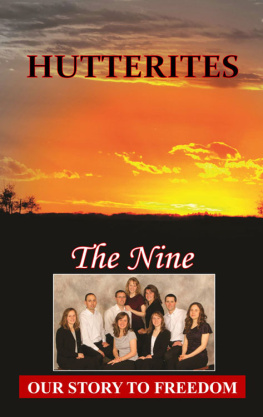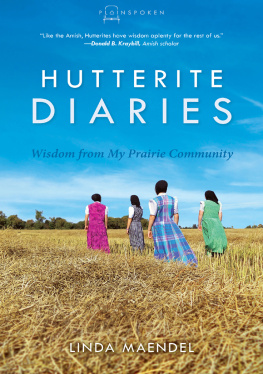Concise Encyclopedia of Amish, Brethren, Hutterites, and Mennonites
CONCISE ENCYCLOPEDIA of Amish, Brethren, Hutterites, and Mennonites

Donald B. Kraybill
THE JOHNS HOPKINS UNIVERSITY PRESS
Baltimore
2010 The Johns Hopkins University Press
All rights reserved. Published 2010
Printed in the United States of America on acid-free paper
2 4 6 8 9 7 5 3 1
The Johns Hopkins University Press
2715 North Charles Street
Baltimore, Maryland 21218-4363
www.press.jhu.edu
Library of Congress Cataloging-in-Publication Data
Concise encyclopedia of Amish, Brethren, Hutterites, and Mennonites / Donald B. Kraybill.
p. cm.
Includes bibliographical references and index.
ISBN-13: 978-0-8018-9657-6 (hardcover: alk. paper)
ISBN-10: 0-8018-9657-6 (hardcover: alk. paper)
1. AnabaptistsEncyclopedias I. Kraybill, Donald B.
BX4931.3.c67 2010
289.7dc22
2009046015
A catalog record for this book is available from the British Library.
Special discounts are available for bulk purchases of this book. For more information, please contact Special Sales at 410-516-6936 or specialsales@press.jhu.edu.
The Johns Hopkins University Press uses environmentally friendly book materials, including recycled text paper that is composed of at least 30 percent post-consumer waste, whenever possible. All of our book papers are acid-free, and our jackets and covers are printed on paper with recycled content.
Editorial Advisory Council
Jeff Bach, Ph.D., Associate Professor of Religion, Elizabethtown College
Janet M. Breneman, D. Min., Former Professor, Latin American Anabaptist Seminary
Kevin Enns-Rempel, M.A., Archivist, Center for Mennonite Brethren Studies, Fresno Pacific University
Rachel Waltner Goossen, Ph.D., Professor of History, Washburn University
Amos B. Hoover, Independent Scholar
Rod Janzen, Ph.D., Distinguished Professor, Fresno Pacific University
James Juhnke, Ph.D., Professor Emeritus of History, Bethel College
John A. Lapp, Ph.D., Executive Secretary Emeritus, Mennonite Central Committee
Royden Loewen, Ph.D., Professor of Mennonite Studies, University of Winnipeg
Juan Martnez, Ph.D., Associate Professor of Hispanic Studies, Fuller Theological Seminary
Steven M. Nolt, Ph.D., Professor of History, Goshen College
John D. Roth, Ph.D., Professor of History, Goshen College
Sara Wenger Shenk, Ed.D., President, Associated Mennonite Biblical Seminary
E. Morris Sider, Ph.D., Professor Emeritus of History, Messiah College
David Rempel Smucker, Ph.D., Independent Scholar
Sam Steiner, M.L.S., Librarian and Archivist (Retired), Conrad Grebel University College
Diane Zimmerman Umble, Ph.D., Professor of Communication, Millersville University
Contents
Acknowledgments
Many people have contributed their expertise and assisted in gathering information for the Concise Encyclopedia. Members of the Editorial Advisory Council deserve special recognition for their advice and suggestions, which have enhanced the accuracy of the text. I especially thank one member, David Rempel Smucker, who played a significant role in helping to conceptualize the project, develop guidelines, and organize the content. Moreover, he researched and wrote an early draft of many of the entries. My Young Center colleague Steve Scotts encyclopedic knowledge of Old Order communities in North America was indispensable in collecting information on those groups. Royden Loewen, Sam Steiner, and Daryl Yoder-Bontrager drafted entries related to their areas of expertise, for which I am grateful.
I owe an enormous debt to my colleague Cynthia Nolt for her exceptional editorial support in all phases of the project and especially for her sharp eye for detail and stylistic consistency. I also thank Kathryn Eisenbise, Megan Memoli, and Lauren Stoltzfus, who performed clerical and research tasks during several stages of the project.
Numerous people generously contributed their time by providing information, suggesting revisions, and reviewing drafts of entries. Some key persons who deserve special recognition include Conrad Kanagy, Eleanor Miller, Linda Shelly, and an anonymous reviewer for the Johns Hopkins University Press. In addition, dozens of staff people representing denominations and agencies as well as leaders and members of various groups graciously gave their time and provided information. Graphic designer Linda Eberly produced the illustrations.
Two books, Anabaptist World USA (Kraybill and Hostetter, 2001) and One Quilt, Many Pieces (M. Reimer, 2008), provided helpful background resources on numerous church groups. Church Member Profile 2006, a survey of members (in the United States) of the Brethren in Christ, the Church of the Brethren, and Mennonite Church USA, was a key source of attitudinal data. I thank the editors of Brethren Encyclopedia, Global Anabaptist Mennonite Encyclopedia Online, and Mennonite Encyclopedia for access to and use of their scholarly resources for this project. I am especially grateful for the resources provided by the Young Center for Anabaptist and Pietist Studies at Elizabethtown College and its director, Jeff Bach, for abundant support of my work on the encyclopedia over several years.
Overview
Purpose
This encyclopedia provides a succinct overview of the history, religious beliefs, and cultural practices of four North American religious families: Amish, Brethren, Hutterites, and Mennonites. These families include more than 200 different groups that trace their roots, inspiration, and/or affiliations back to the Anabaptist Movement in Europe during the 16th-century Protestant Reformation. The nearly 350 short entries in this volume offer students, journalists, scholars, and general readers a synopsis of key topics and snapshots of Anabaptist groups in the 21st century. Ample references provide additional resources for more in-depth research.
Scope
The volume focuses on 21st-century Anabaptist communities in North America (Canada, the Caribbean, Central America, Mexico, and the United States), where Anabaptist-related groups are found in 17 of the 23 countries. The United States is home to all four of the Anabaptist families, and Canada is home to three of them (Amish, Hutterites, and Mennonites). Brethren and Mennonites, but no Amish or Hutterites, live in the Caribbean region. Mennonite groups are the primary Anabaptist presence in the Central American countries and Mexico. Although the entries cover a wide range of information, they emphasize culture and 20th-century social history more than theology or European Anabaptist history. This work is not comprehensive or exhaustive. Scholars seeking in-depth treatments of the topics will find electronic resources (web sites) at the end of some entries, as well as printed resources in the References section.
Entries
There is an entry on each of the four Anabaptist familiesAmish, Brethren, Hutterites, and Mennonitesas well as entries on a wide range of topics related to religious views and social practices. In addition, each organized church group with 5,000 or more baptized members has an entry, as does each country in North America. Because many Anabaptist groups, especially those in Canada and the United States, have European origins, each of the following countries has an entry: Austria, France, Germany, the Netherlands, Poland, Russia, and Switzerland.
Next page




